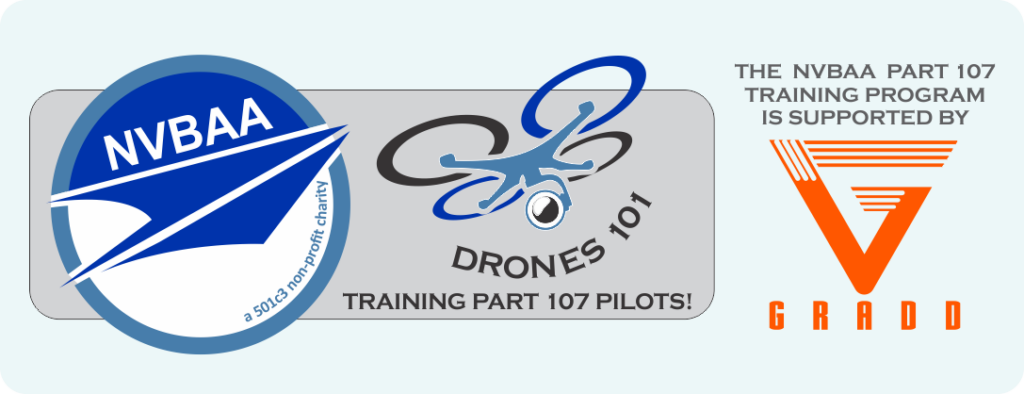Our NVBAA FAA Part 107 Test Prep Course is facilitated through an online self-paced learning management system. In addition, we provide weekly training calls every Saturday at 9 am PT to review the more difficult parts of the course. We also conduct a 30 question interactive quiz on our weekly Saturday training calls. Attend our weekly training calls, complete our online course and you’re guaranteed to pass the FAA Part 107 Exam! All of our Part 107 learners pass the FAA Part 107 Remote Pilot Certification Exam on the first try! We still have room in our Mar-Apr 2021 class, or you may apply to enroll into our May or July classes!
We offer this training FREE of charge to Public Safety Officers, Military Veterans, High School Teachers/Admin and HS Students!
Scroll to the bottom of this page to complete the enrollment application.

COMPLETE THE APPLICATION AT THE BOTTOM OF THIS PAGE TO ENROLL IN OUR FREE PART 107 TEST PREP TRAINING COURSE. PLEASE NOTE THAT OUR TRAINING IS FREE FOR HIGH SCHOOL STUDENTS, HIGH SCHOOL TEACHERS, MILITARY VETERANS AND PUBLIC SAFETY OFFICERS.
Certificated Remote Pilots including Commercial Operators
Source: https://www.faa.gov/uas/commercial_operators/
- CURRENCY UPDATE: The FAA has published a Special Federal Aviation Regulation (SFAR) on how Part 107 certificated pilots can establish currency while testing centers are closed due to COVID-19 response. Read the Frequently Asked Questions (PDF).
If you have a small drone that is less than 55 pounds, you can fly for work or business by following the Part 107 guidelines.
To fly under Part 107 rules, there are 3 main steps:
Step 1: Learn the Rules
- Make sure you understand what is and is not allowed under Part 107 rules. Review a summary of the Part 107 rules (PDF) .Still unsure if Part 107 rules work for you and your intended operation? Check our user identification tool.
- Some operations are not covered by Part 107 and will require a waiver. Here are some common examples of Part 107 sections that are subject to waiver:
- Operation from a moving vehicle or aircraft (§ 107.25) *
- Daylight operation (§ 107.29)
- Visual line of sight aircraft operation (§ 107.31) *
- Visual observer (§ 107.33)
- Operation of multiple small unmanned aircraft systems (§ 107.35)
- Yielding the right of way (§ 107.37(a))
- Operation over people (§ 107.39)
- Operation in certain airspace (§ 107.41)
- Operating limitations for small unmanned aircraft (§ 107.51)
- Drone operators should avoid flying near airports because it is difficult for manned aircraft to see and avoid a drone while flying. Remember that drone operators must avoid manned aircraft and are responsible for any safety hazard their drone creates in an airport environment. Read more about flying near airports.
Step 2: Become an FAA-Certified Drone Pilot by Passing the Knowledge Test
- To be eligible to get your Remote Pilot Certificate, you must be:
- At least 16 years old
- Able to read, write, speak, and understand English
- Be in a physical and mental condition to safely fly a UAS
- Review the full process to get your Remote Pilot Certificate.
- Study for the Knowledge Test by reviewing the Test Prep materials provided by the FAA.
- Obtain an FAA Tracking Number (FTN) by creating an Integrated Airman Certification and Rating Application (IACRA) profile prior to registering for a knowledge test.
- Schedule an appointment to take the Knowledge Test at an FAA-approved Knowledge Testing Center.
- Once you’ve passed your test, complete FAA Form 8710-13 for a remote pilot certificate (FAA Airman Certificate and/or Rating Application) using the electronic FAA Integrated Airman Certificate and/or Rating Application system (IACRA)*
Step 3: Register your Drone(s) with the FAA
- Registration costs $5 and is valid for 3 years. You’ll need a credit or debit card and the make and model of your drone handy in order to register.
- Visit dronezone.faa.gov and select “Fly sUAS under Part 107” to create an account and register your drone.
- Once you’ve registered, mark your drone (PDF) with your registration number in case it gets lost or stolen.
Remember:
- Always be sure to fly your drone safely and within FAA guidelines and regulations.
- It is up to you as a drone pilot to know the Rules of the Sky, and where it is and is not safe to fly.
